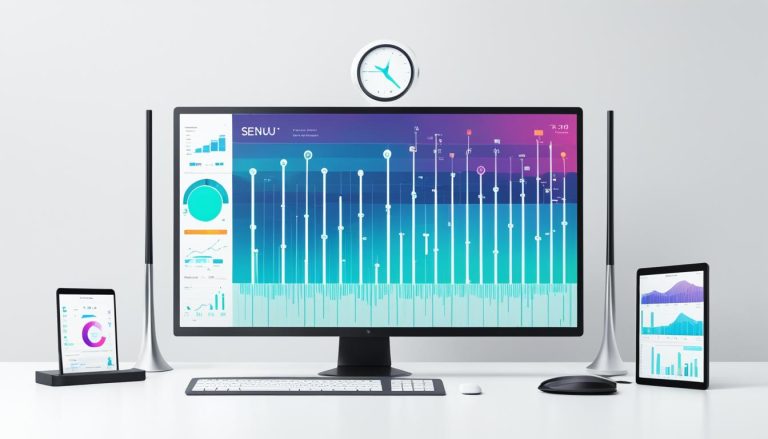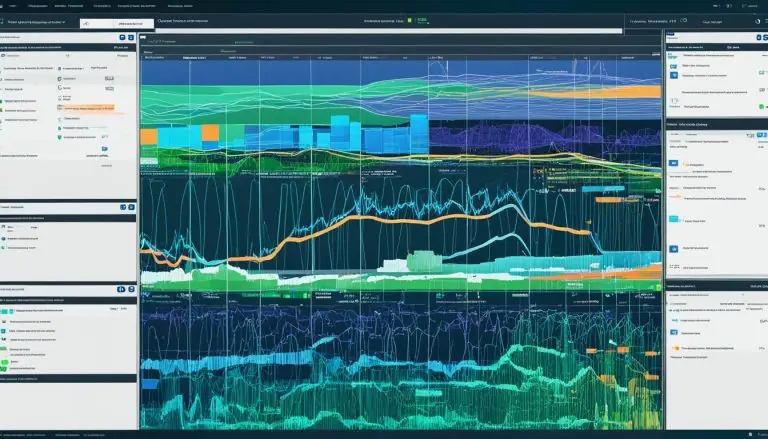Comparing Network Tools: Observium vs. LibreNMS
In today’s fast-paced digital age, network monitoring has become an integral part of every organization’s IT infrastructure. As businesses continue to become more dependent on their networks, the demand for network monitoring tools has grown significantly. Among the popular network monitoring tools, Observium and LibreNMS are two names that have gained a lot of traction among IT professionals. But which one is the best? Which tool offers the most comprehensive features and capabilities for network performance management?
Key Takeaways:
- Observium and LibreNMS are popular open-source network monitoring tools.
- Observium uses SNMP for data collection, while LibreNMS utilizes SNMP, WMI, and SSH.
- Observium offers more comprehensive performance monitoring capabilities, while LibreNMS focuses on device discovery and system performance.
- Observium is known for its user-friendly interface, while LibreNMS is highly customizable and scalable.
- Observium has a paid version with additional features, while LibreNMS is completely free and open-source.
Observium vs. LibreNMS: Approach to Data Collection
When comparing Observium and LibreNMS, one of the key differences lies in their approach to data collection. Observium primarily relies on SNMP (Simple Network Management Protocol) to collect data from network devices, allowing it to gather essential information about the performance and health of these devices.
On the other hand, LibreNMS takes a more comprehensive approach by utilizing a combination of SNMP, WMI (Windows Management Instrumentation), and SSH (Secure Shell) protocols for data collection. This combined approach enhances the capability of LibreNMS to collect detailed information from a broader range of network devices.
This means that LibreNMS is not only capable of gathering data from devices that support SNMP but can also access and collect information from devices that do not have SNMP capabilities. The inclusion of WMI and SSH protocols allows LibreNMS to provide more in-depth insights into the performance and health of various network devices, regardless of their SNMP compatibility.
By employing a combination of protocols, LibreNMS ensures that network administrators can receive a holistic view of their network infrastructure, including devices that may not support SNMP. This enables better monitoring and management of the entire network ecosystem, providing IT teams with a more comprehensive understanding of their infrastructure.
Observium vs. LibreNMS: Monitoring Features
When comparing Observium and LibreNMS, it’s important to consider their monitoring features. Observium offers a range of comprehensive capabilities for performance monitoring, making it a reliable choice for network monitoring. Its real-time performance monitoring feature allows you to stay updated on the health and performance of your network, ensuring optimal functionality.
Another essential monitoring feature of Observium is device discovery. With Observium, you can easily discover and add devices to your network, enabling you to effectively monitor a wide range of devices across your infrastructure. This feature simplifies the setup process and ensures that you have visibility into your entire network.
Alerting is another critical component of network monitoring, and Observium excels in this area. Its alerting feature allows you to set up notifications for specific events or performance thresholds, ensuring that you are promptly informed of any issues that may arise. This proactive approach helps you address network problems quickly, minimizing downtime and optimizing performance.
Graphing is an important monitoring feature for visualizing network data trends and analyzing performance over time. Observium’s graphing capability provides intuitive and visually appealing graphs, enabling you to easily interpret and analyze network performance metrics. By visually representing data, you can identify patterns, trends, and anomalies, allowing for more effective troubleshooting and decision-making.
On the other hand, LibreNMS focuses more on device discovery, system performance monitoring, and alerting. While it may not provide the same level of real-time performance monitoring and graphing capabilities as Observium, LibreNMS offers a robust solution for discovering devices on your network and monitoring their overall performance.
“Observium offers comprehensive performance monitoring, device discovery, alerting, and graphing features, making it a powerful network monitoring tool.”
In conclusion, Observium’s monitoring features, such as real-time performance monitoring, device discovery, alerting, and graphing, make it an excellent choice for organizations looking for a network monitoring tool with comprehensive capabilities. However, if your focus is more on device discovery and system performance monitoring, LibreNMS may better suit your needs. Ultimately, the choice between Observium and LibreNMS will depend on your specific monitoring requirements and priorities.
Observium vs. LibreNMS: Ease of Use and Scalability
When it comes to network monitoring tools, ease of use and scalability are crucial factors to consider. Observium and LibreNMS are both popular choices, but they differ in terms of their user-friendliness and customization options.
Observium is known for its straightforward and intuitive interface, making it easy for users to navigate and understand. Its simple setup process makes it an ideal option for smaller organizations or those with limited technical expertise. With Observium, users can quickly configure and deploy the monitoring tool without much hassle.
On the other hand, LibreNMS offers more customization options, making it a great fit for larger organizations with complex network environments. Its scalability allows businesses to expand their monitoring capabilities as their network grows. However, this customization and scalability come at the cost of a steeper learning curve and a more involved setup process. Users may need to possess a certain level of technical expertise to effectively utilize the full potential of LibreNMS.
In terms of ease of use, Observium’s user-friendly interface provides a more seamless experience, especially for users with limited technical knowledge. Its simplicity allows organizations to quickly get up and running without extensive training. LibreNMS, on the other hand, requires a deeper understanding of network monitoring tools and may demand more technical expertise to fully leverage its capabilities.
In conclusion, if your organization prioritizes simplicity, ease of use, and quick setup, Observium is a suitable choice. However, if you require a more customizable and scalable solution, and have the technical expertise to handle it, LibreNMS offers greater flexibility. Consider your organization’s specific needs and technical capabilities when deciding between the two.
Observium vs. LibreNMS: Pricing Models
When comparing network monitoring tools like Observium and LibreNMS, understanding their pricing models is crucial. Observium offers both a free and a paid version, providing users with the flexibility to choose the option that suits their needs best. The free version of Observium is ideal for small organizations or individuals looking for basic network monitoring capabilities. However, for additional features and enhanced support, upgrading to the paid version is recommended.
The paid version of Observium includes advanced features such as custom alerting and reporting, distributed monitoring, and support for larger networks. The added benefits of the paid version ensure that users have access to more comprehensive functionality and technical support when needed, making it a suitable choice for organizations with complex network environments.
On the other hand, LibreNMS follows an open-source model, meaning that it is completely free to use. This makes LibreNMS an attractive option for organizations on a tight budget or those who prefer open-source software solutions. However, it is important to note that configuring and maintaining LibreNMS may require more technical expertise, as it relies on community support rather than dedicated customer support channels.
When selecting between the two, consider your organization’s specific requirements, technical capabilities, and available resources. If you prioritize additional features, direct support, and simplicity, Observium’s paid version might be the most suitable choice. Conversely, if you value open-source flexibility and have the technical expertise to handle configuration and maintenance independently, LibreNMS offers an excellent free option.
Observium vs. LibreNMS: A Cost-Effective Monitoring Solution
Choosing the right network monitoring tool is crucial for ensuring the stability, performance, and security of your organization’s network infrastructure. While Observium’s paid version offers additional features and support, LibreNMS provides an attractive open-source alternative, especially for those with technical expertise. Ultimately, the decision should be based on a careful evaluation of your organization’s needs, available resources, and long-term goals.
Observium vs. LibreNMS: Device and Protocol Support
When it comes to device and protocol support, both Observium and LibreNMS offer extensive capabilities for network monitoring.
Observium provides support for a wide array of devices and operating systems, including Cisco, Juniper, Brocade, Dell, HP, Mikrotik, and many more. This diverse range of supported devices ensures that Observium can effectively monitor and manage networks regardless of the equipment being used.
LibreNMS, on the other hand, also boasts a comprehensive list of supported network devices, which includes popular brands such as Cisco, HP, Juniper, Fortinet, and Aruba. This enables LibreNMS to effectively monitor networks using a wide variety of network equipment.
Both tools excel in their ability to support a range of devices and provide compatibility with industry-leading brands. However, Observium has a slightly longer list of supported devices, giving it an edge in terms of device support.
Protocol Support
When it comes to protocol support, Observium relies primarily on SNMP (Simple Network Management Protocol) to collect data from network devices. SNMP is a widely adopted industry standard, making it compatible with most network equipment.
In contrast, LibreNMS utilizes a combination of protocols, including SNMP, WMI (Windows Management Instrumentation), and SSH (Secure Shell). This multi-protocol approach allows LibreNMS to collect more detailed information from a wider range of devices, including those that do not support SNMP.
This comprehensive protocol support enhances LibreNMS’s flexibility in monitoring different types of network devices, providing more in-depth visibility into network performance.
Overall, both Observium and LibreNMS offer robust support for devices and protocols. Whether you have a diverse network environment with a broad range of equipment or require comprehensive data collection from various devices, both tools possess the capabilities to meet your network monitoring needs.
“Observium offers support for a vast array of devices and operating systems, including Cisco, Juniper, Brocade, Dell, HP, Mikrotik, and more.”
“LibreNMS utilizes a combination of protocols, including SNMP, WMI, and SSH, allowing it to collect more detailed information from a wider range of devices.”
Observium vs. LibreNMS: User Base and Community
When it comes to network monitoring tools, the user base and community support are crucial factors to consider. In this section, we will explore the user base and community of both Observium and LibreNMS, providing insights into their support and troubleshooting capabilities.
Observium User Base and Community
Observium has been in the market for a longer time compared to LibreNMS, which has helped it build a more established user base and community. The longevity of Observium’s presence has allowed it to accumulate a large number of users who contribute to its development, share knowledge, and provide support when needed.
Observium’s longstanding user base provides an advantage when it comes to finding support and troubleshooting issues. Its community members have gained significant experience and expertise in using the tool, making it easier for new users to find solutions to their problems.
Whether you need assistance with installation, configuration, or solving specific network monitoring challenges, Observium’s user base and community can be a valuable resource for troubleshooting and support.
LibreNMS User Base and Community
While Observium has a more established user base, LibreNMS is catching up rapidly. It has been gaining popularity among network administrators, system administrators, and other IT professionals due to its open-source nature and robust features.
LibreNMS has a passionate community of developers and users who actively contribute to its development, enhance its functionality, and provide support to the user community. This active community fosters collaboration and encourages sharing of knowledge, making troubleshooting and finding solutions easier for users.
Whether you’re looking for guidance on technical issues or seeking advice on how to get the most out of LibreNMS, the active community surrounding the tool can provide valuable insights and assistance.
User Base and Community Support
Both Observium and LibreNMS boast strong user bases and active communities that offer valuable support for network monitoring and troubleshooting issues. The established user base of Observium provides a wealth of knowledge and expertise, while LibreNMS’s growing community offers fresh perspectives and innovative solutions.
When selecting a network monitoring tool, it’s important to consider the user base and community support. Assessing the available resources and community engagement can help ensure that you have access to the necessary knowledge and support to address any challenges that may arise during the implementation and use of the tool.

With their strong user bases and dedicated communities, both Observium and LibreNMS provide reliable support and troubleshooting options for network monitoring. Whether you choose Observium’s more established user base or LibreNMS’s growing community, you can rest assured that you’ll have access to resources and guidance to overcome any obstacles you may encounter.
An In-Depth Analysis of Observium and LibreNMS
When it comes to network monitoring tools, Observium and LibreNMS are two powerful options that offer a range of features and capabilities. In this section, we will take an in-depth look at both tools, exploring their strengths and benefits for monitoring network performance and ensuring network health.
Observium: Detailed Insights into Network Performance and Health
Observium is a comprehensive network monitoring tool that provides detailed insights into network performance and health. With its user-friendly interface, Observium makes it easy for IT professionals to monitor and analyze network data. It supports a wide range of devices and protocols, allowing for seamless integration into existing network infrastructures.
One of the key advantages of Observium is its ability to collect and analyze real-time data, providing immediate visibility into network performance. From monitoring bandwidth usage to tracking device connectivity, Observium offers a wealth of information that helps organizations maintain optimal network operations.
LibreNMS: Customizable and Scalable Open-Source Monitoring
On the other hand, LibreNMS is an open-source network monitoring system that offers a high level of customization and scalability. It provides real-time monitoring and alerting, making it an ideal choice for large-scale networks.
With LibreNMS, organizations have the flexibility to adapt the tool to their specific monitoring needs. Its open-source nature allows for community contributions and extensions, ensuring that users can tailor the system to suit their individual requirements. Additionally, LibreNMS supports a variety of protocols, enabling compatibility with a wide range of network devices.
Choosing the Right Tool for Your Network Monitoring Needs
Both Observium and LibreNMS have their strengths when it comes to network monitoring. Observium offers detailed insights into network performance with its user-friendly interface, making it a great choice for organizations seeking comprehensive monitoring capabilities. On the other hand, LibreNMS provides the flexibility of customization and scalability, making it an attractive option for larger networks.
Ultimately, the choice between Observium and LibreNMS depends on your organization’s specific requirements and preferences. Consider factors such as the size of your network, the level of technical expertise available, and the desired level of customization. This in-depth analysis should help you make an informed decision that aligns with your organization’s network monitoring goals.
Evaluating the Pros and Cons: Observium vs. LibreNMS
When it comes to choosing a network monitoring tool, it’s essential to evaluate the pros and cons of each option. Observium and LibreNMS both have their strengths and weaknesses, which can significantly impact your decision. Let’s take a closer look at the key factors to consider.
Features and Customization
Observium offers extensive features for network monitoring, including real-time performance monitoring, device discovery, alerting, and graphing. It provides a comprehensive set of tools to ensure that you have a complete view of your network’s health and performance. Additionally, Observium allows for customization, allowing you to tailor the tool to meet your specific requirements.
On the other hand, LibreNMS is an open-source network monitoring tool that also offers a wide array of features, including device discovery, system performance monitoring, and alerting. While it may not have the same level of customization as Observium, it provides a solid foundation for monitoring and managing your network.
Technical Expertise
When it comes to technical expertise, Observium may require more knowledge and experience to set up and maintain effectively. It offers advanced features and customization options that may require a higher level of technical proficiency. However, if you have a dedicated IT team or experts in network management, this should not pose a significant challenge.
On the other hand, LibreNMS, as an open-source tool, may be more accessible to users with varying levels of technical expertise. It has a user-friendly interface and is relatively easy to set up, making it a viable option for organizations without advanced technical resources.
Cost
Observium offers a paid version that provides additional features and support. While the paid version comes at a cost, it may be worth the investment for organizations that require advanced functionality and dedicated support.
In contrast, LibreNMS is completely open-source and free to use, making it an attractive option for organizations looking to cut costs. However, it’s important to consider that the level of support and customization may be limited, and organizations may need to rely on community support for troubleshooting and assistance.
Conclusion
When evaluating network monitoring tools like Observium and LibreNMS, it’s important to consider your organization’s specific needs and preferences. Observium offers a comprehensive set of monitoring features with a user-friendly interface, making it a popular choice for organizations seeking simplicity and ease of use. On the other hand, LibreNMS provides more customization options and scalability, making it a great fit for larger organizations with complex network environments.
In making your decision, take into account factors such as device support, monitoring features, ease of use, pricing, and community support. Observium supports a wide range of devices and protocols, while LibreNMS has a growing community of developers and users contributing to its development. Consider whether you need real-time performance monitoring, device discovery, alerting, or customizable graphing capabilities for your network monitoring needs.
Ultimately, the best network monitoring tool for your organization depends on a careful evaluation of your specific requirements. Observium and LibreNMS both offer unique strengths and advantages. Whether you prioritize user-friendliness and a robust feature set or customization and scalability, these tools have you covered. Take the time to assess your needs and choose the network monitoring tool that aligns best with your organization’s goals and infrastructure.
FAQ
What are Observium and LibreNMS?
How do Observium and LibreNMS differ in their approach to data collection?
What monitoring features do Observium and LibreNMS offer?
Which tool is easier to set up: Observium or LibreNMS?
Are Observium and LibreNMS free to use?
What devices and protocols do Observium and LibreNMS support?
Which tool has a larger user base and community support?
How do Observium and LibreNMS compare in terms of network performance and health analysis?
What are the pros and cons of Observium and LibreNMS?
Which is the best network monitoring tool: Observium or LibreNMS?
Source Links
- https://www.playerzero.ai/advanced/product-builder-facts/observium-vs-librenms
- https://stackshare.io/stackups/librenms-vs-observium
- https://www.webhostingtalk.com/showthread.php?t=1900917
- About the Author
- Latest Posts
Mark is a senior content editor at Text-Center.com and has more than 20 years of experience with linux and windows operating systems. He also writes for Biteno.com






